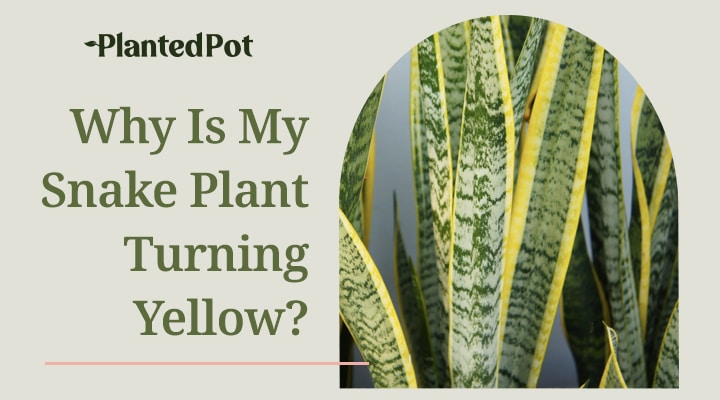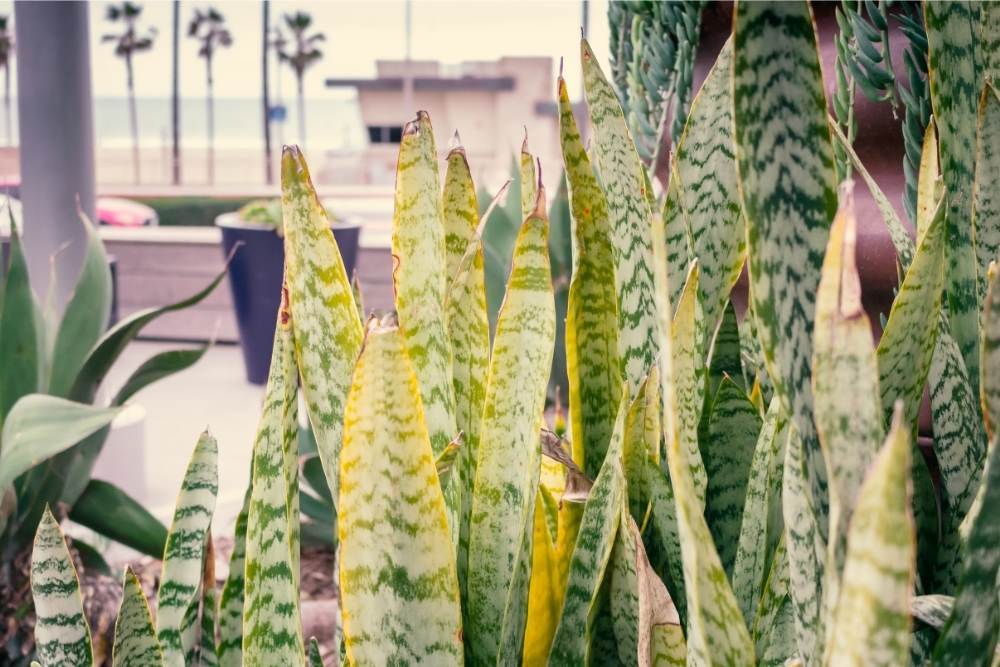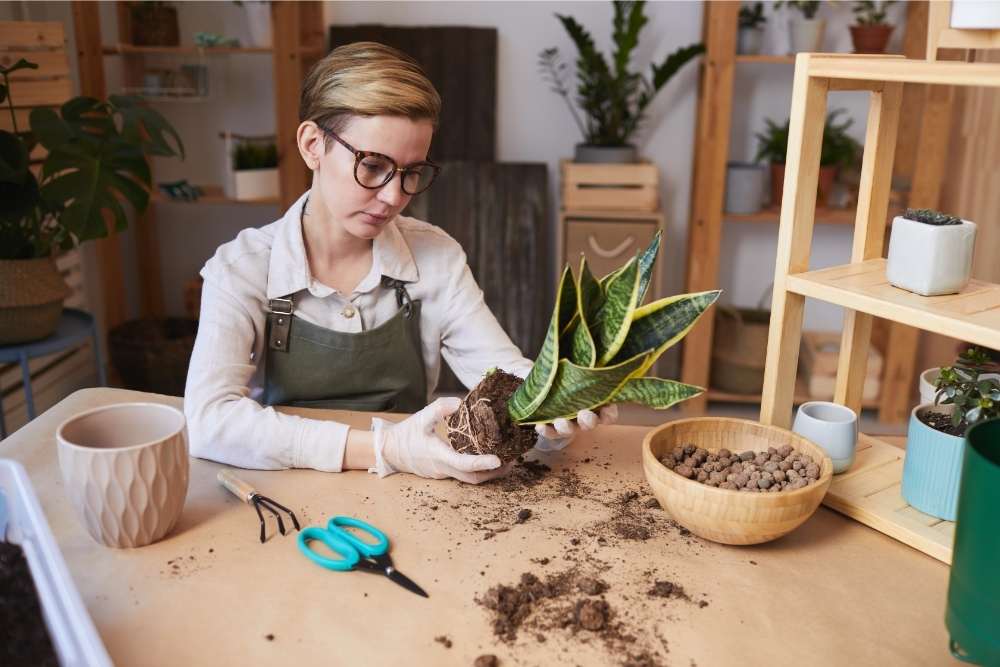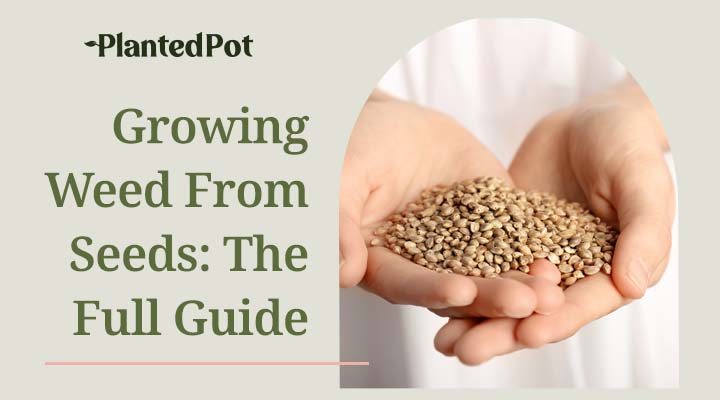
Why Is My Snake Plant Turning Yellow? [And What You Can Do to Save It!]
Home / Why Is My Snake Plant Turning Yellow? [And What You Can Do to Save It!]

Why Is My Snake Plant Turning Yellow? [And What You Can Do to Save It!]
Snake Plants are known for their durability and resistance, making them the ideal indoor plant. This striking plant can survive underwatering, dim lighting, and more. But sometimes Snake Plants need a bit of TLC. You’ll know this when you see their leaves turning yellow. So why is my Snake Plant turning yellow?
There are many reasons why your Snake Plant’s leaves change color. Luckily for plant parents, once you identify the reason for what’s causing your leaves to turn yellow, you can make some changes to revive it! Keep reading to find out how to keep your Snake Plant healthy and happy without that dangerous yellow tint!
What Are Snake Plants?
Snake Plants are well known for their bright, tropical looks and extreme hardiness. From homes, offices, and hotels, chances are you’ll find Snake Plants almost everywhere due to how incredibly low maintenance they are. In addition to their hardiness and beauty, they also help to purify indoor air.
The Snake Plant, sometimes called Mother-in-Law’s Tongue, goes by the scientific name Sansevieria Trifasciata. It’s native to tropical western Africa, where its natural habitat is warm and humid. This evergreen perennial has no stem and long, stiff, vertical green leaves with yellow borders and yellow stripes. Although this is rare indoors, they can grow up to four feet tall and sport off-white blooms in the spring with the right care.
While the Snake Plant is considered a tropical plant due to its natural habitat, it is actually pretty tolerant of various environments, just as long as they get the proper care. This hardy plant can survive low light levels and drought and will often still sport bold, stiff leaves. These attributes are why Snake Plants are one of the most popular indoor plants.
Why Is My Snake Plant Turning Yellow?
Although Snake Plants are very versatile plants, that doesn’t mean they will thrive perfectly without the right care. Yellow leaves are your Snake Plant’s way of letting you know something is wrong. Here are the most common reasons why your Snake Plant leaves turn yellow.
Soil Is Too Moist
Snake Plants thrive without a lot of watering. You should only water your Snake Plant when the top half of the soil is completely dry. When your plant is sitting in too much water, fungal growth can occur, leading to fungal diseases and root rot and eventually killing your plant.
Not Enough Water
While Snake Plants can survive weeks without water, that doesn’t mean it’s always the best option. If you go on vacation or forget to water your plant for weeks, keep in mind that your Snake Plant won’t be getting the nutrients it needs from the soil. Your plant will become dehydrated, resulting in yellow leaves.
Inconsistent Watering
When you go back and forth between watering routines, like keeping the soil bone-dry for a while and then very wet for a week, your plant can become stressed. As a result of this drastic watering schedule, your Snake Plant’s leaves will start to turn yellow.
Too Much Direct Sunlight
Snake Plants that get too much sunlight can become sunburned. Sunlight through the window can damage your plant’s leaves, so can planting your Snake Plant in an outdoor spot without any shade. If your plant is getting too much direct sunlight, not only will the leaves yellow, but the tips will start to brown, signifying the death of the leaf tissue.
Pests
A weakened or stressed plant is more susceptible to pest infestations. These pests will suck the sap from your plant, draining them of moisture. After a while, pests like spider mites and mealybugs will move up your plant’s leaves. When this happens, your Snake Plant will rapidly turn yellow.
Overfertilization
Snake Plant leaves will turn yellow with too much fertilizer. Although nutrient-rich fertilizer is good for a plant and provides a boost of nutrition, too much of a good thing can be bad. This isn’t a plant that needs a lot of fertilizer, and overfeeding can cause a lot of harm to your Snake Plant and harm their healthy leaves.
Aging
Snake Plants usually live around five to 10 years. When your plant ages, the leaves turn naturally yellow. However, this doesn’t mean your plant is dying. A natural process of a Snake Plant includes their older leaves turning yellow and falling off. But have no fear! New leaves will replace these old, yellowing leaves.

Is It Common For Snake Plant Leaves to Turn Yellow?
It’s not common for Snake Plant leaves to turn yellow. Their leaves will only turn yellow if something is wrong. When a Snake Plant’s leaves turn yellow, that usually means that the plant is experiencing root rot from improper watering or pests. Yellow leaves can also signify too much sunlight, causing the plants to turn yellow and become sunburned.
Can Yellow Snake Plant Leaves Turn Green Again?
Yes, they can! A yellowing Snake Plant can recover with the right care. Plant leaves turning yellow doesn’t mean that it’s is automatically dead or a lost cause. Oftentimes, yellow leaves are just a warning sign that something is wrong with the plant. Luckily, you can heed this warning and actively help your Snake Plant recover from whatever troubles it.
How To Revive A Snake Plant That’s Turning Yellow
If your Snake Plant has yellow leaves, don’t panic just yet. Yellow leaves don’t mean your plant is at death’s door. Rather, Snake Plants are hardy and will survive almost anything. Here is how to revive a Snake Plant that’s turning yellow.
Repot Your Plant
Your Snake Plant might have outgrown its pot. If this is the case, it’s time for a new pot to save your yellowing Snake Plant. Let the plant dry on a paper towel and clip away parts of the root ball that are soft and darkened. These areas are dead from root decay.
When choosing a new pot, make sure it has adequate drainage holes to prevent excess water from accumulating inside the pot’s base and allow for proper drainage. This will ensure the soil doesn’t remain damp and prone to root rot.
Ensure your Snake Plant’s roots are not too cramped within the pot by putting it in a slightly larger pot than the one it was previously in. But don’t get a pot that’s too big. Not only will a bigger pot also contain more soil, but it will also contain more moisture, making the plant dry out slower.
Replace the Soil
Even if you are giving your Snake Plant the right amount of water, it’s still possible for the plant to still experience root rot. Some types of soil hold moisture more than others. To alleviate this problem, all you have to do is give your plant some fresh soil.
Try switching to a soil mix that’s formulated specifically for succulents. These soils are made to replicate the well-draining soil in the Snake Plant’s natural habitat and help prevent overwatering and root rot.
Reduce Watering
If you water your Snake Plant more than once a week, your Snake Plant is probably drowning, and root rot is setting in. Water them every two or three weeks instead, allowing the soil to dry completely between watering.
You can determine if your Snake Plant is ready for watering by checking the top two inches of soil. If the soil is dry to the touch and lacking moisture, then it’s time for watering.
Propagate Your Snake Plant
If your Snake Plant is suffering from severe root rot, you can cut off any remaining leaves that are still healthy for propagation. Snake Plants are easy to propagate.
Here is how you can propagate your Snake Plant in three simple steps:
- Choose a healthy leaf and cut the entire leaf off by making an upside-down v-shaped cut, preferably near the base.
- Let the cutting dry for 1-2 days.
- Place the cutting in fresh potting mix and water.
- Congratulations, you have a brand new Snake Plant! Take care of it like you would any other Snake Plant.

How to Prevent A Snake Plant’s Leaves From Turning Yellow
Even if you have a healthy Snake Plant, it can be scary to think of Snake Plant leaves turning yellow and dying. Luckily there are easy ways to prevent their leaves from yellowing. Here is how to keep your Snake Plant healthy.
Consistent Water Schedule
Water your Snake Plant every two weeks (sometimes be up to six weeks depending on weather and temperature). You should only water your Snake Plant when the soil is dry. Don’t switch up the watering schedule; your plant may go into shock if you do.
Keep Your Plant in Indirect Sunlight
Too much sunlight can scorch your Snake Plant’s leaves. Make sure you place your Snake Plant in a spot that’s sunny but doesn’t have direct sun for more than a few hours a day. Keep your Snake Plant in areas with indirect sunlight to ensure that it can grow properly and thrive.
Don’t Overfertilize
It can seem healthy to give your plant fertilizer. But Snake Plants don’t like too much of the stuff. In the summer, during a Snake Plant’s growing period, fertilize your plant every few weeks. When your Snake Plant goes dormant in the winter, don’t give it any fertilizer.
Keep an Eye On Pests
Check your Snake Plant’s soil and leaves for pests. You’ll often see them on top of the soil, a little below the surface, or on the underside of leaves. You can control pests by spritzing your Snake Plant’s leaves with some water. Keeping your plant healthy will also make them less susceptible to pest infestations.
Final Thoughts – Why Is My Snake Plant Turning Yellow?
Snake Plants are identifiable due to their bright, green leaves that stand upright and stiff. So when the leaves turn yellow and are curling or wilted, it can be quite a concern and an uneasy sight for plant owners. There are many reasons why Snake Plants start to yellow. Most of the time, yellow leaves are a signifier that something is wrong with your Snake Plant.
Once you identify why your plant is struggling, you can make some changes to your Snake Plant’s care. With the right watering, lighting, temperature, and soil, your Snake Plant will remain bright, green, and healthy! If reading this has made you want to get a Snake Plant of your own, then head on over to our shop and have one (or several) of these majestic plants delivered right to your door!



